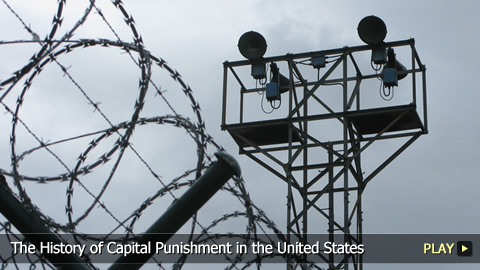The History of Capital Punishment in the United States

This is the harshest penalty allowed by the courts. Welcome to WatchMojo.com, and today we’re taking a look at the history of Capital Punishment in the United States.
The idea of killing as a form of retribution for one’s crimes dates back centuries, but was imported to America by British settlers during the Colonial Era. It officially began early in the seventeenth century, when crimes like stealing vegetables, trading with Indians or rejecting the idea of one God were considered capital crimes at one point.
Hanging was the preferred method of execution; however, more horrific means like burning, beating and breaking on a wheel were also used, though infrequently.
Movements against capital punishment began early, and were supported by important figures of the day. In 1777, Founding Father Thomas Jefferson unsuccessfully tried to amend Virginia laws regarding the death penalty to make only murder and treason capital crimes.
However, in 1790, the U.S. Bill of Rights and its Eighth Amendment saw that no cruel or unusual punishment would be inflicted on United States citizens.
When the abolition movement gained steam in the early nineteenth century, states began performing executions in prisons, as opposed to publicly as was once the custom. However, the United States’ last public execution was in 1936.
In 1846, Michigan became the first state to eliminate the death penalty for all crimes except treason. Other states soon did the same.
In the early 1860s, the Civil War derailed abolitionists. But once the war ended, technological advancements eased its use: for example, the electric chair was first used to carry out a death sentence in 1890. This method was considered more humane than hanging and was quickly adopted by New York and a few other states.
In the early twentieth century, the belief that capital punishment was unjust became more widespread when research suggested criminals were victims of genetics and their environments. Some states then eliminated it entirely, while others restricted its use to a few uncommon crimes.
However, this revolution was brief: by 1920, most states had re-established the death penalty due to World War I and the threat of a socialist revolution.
1924 saw the application of the gas chamber as a supposedly more humane option for capital punishment, and this caused a revival in the use of the death penalty as a deterrent. In fact, during Prohibition and the Great Depression of the 1930s, the United States saw its widest use of capital punishment, with an average of almost 170 killed each year.
Public opinion shifted against capital punishment again in the 1950s, and in 1966 it dropped to a record low. During that decade, reinterpretations of the Constitution suggested the death penalty was, in fact, cruel and unusual punishment as stated in the Eighth Amendment and should be considered unconstitutional.
This subject was addressed in the Furman v. Georgia case of 1972. On June 29th that year, the Supreme Court ruled that consistency was necessary when applying the death penalty, and that existing state laws regarding execution were unconstitutional. This effectively put the death penalty on hold in the United States, and saw the sentences for all inmates on death row commuted to life in prison.
To adhere to the findings of Furman, individual states began rewriting their statutes with regards to capital punishment. The Gregg decision of July 2nd, 1976 then saw the death penalty reinstated.
On January 17th the next year, Gary Gilmore became the first execution of the modern era of capital punishment when he was shot by a Utah firing squad. On December 7th, 1982, lethal injection was first used as a method of execution, and it eventually became the preferred way of carrying out sentences.
Support for capital punishment in the United States peaked at 80 percent in 1994, and has declined ever since. The debate was renewed in 2011 when a firestorm ignited following the execution of convicted murderer Troy Davis, as many believed he was innocent.
In recent years, a number of U.S. states abolished the death penalty altogether. However, because of conflicting belief systems, it will undoubtedly remain a divisive topic.
